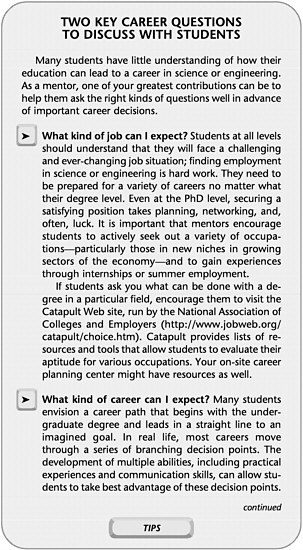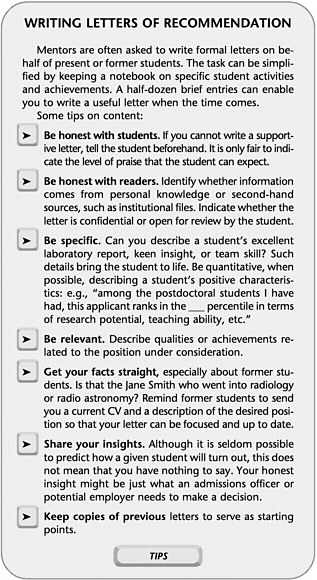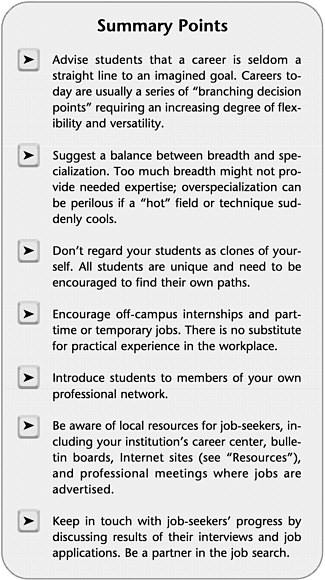3
THE MENTOR AS CAREER ADVISER
Good mentoring in science and engineering has taken on added importance in recent years. Over the last 2 decades, the proportion of PhDs entering traditional academic research and teaching has dropped from over 60% to less than 50%; thus, most new PhDs today find work outside academe. Most scientists and engineers are entering a more diverse employment environment that is characterized by a trend toward more-interdisciplinary, collaborative, and team work. Many of them are preparing for more-integrative, systemic approaches to increasingly complex fields, such as bioscience, environmental studies, and information science.
As the employment environment and the conduct of science and engineering change continuously, it is wise to view the career as an evolutionary process. Students should plan their careers with an eye to steady or even sudden change. They might not know exactly how they will use their education until they begin professional work.
One of the most helpful things you can do for students
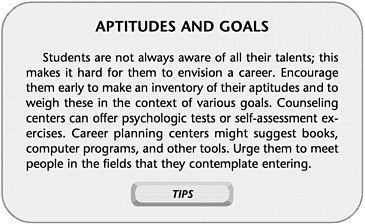
at any stage is to take them on visits to other laboratories or to industrial work sites. Such visits can give students a broad and realistic view of possible careers.
Envisioning and Planning a Career
Even though students cannot know which direction their careers will eventually take, they can help themselves by studying the possibilities. One of the mentor's goals should be to help the student stay aware of evolving career conditions and opportunities.
Encourage students to find out what recent graduates from their department or program have done. Help them recognize fields that are likely to be expanding when they graduate. Many "hot" fields involve cross-disciplinary research and therefore a combination of educational backgrounds and skills. Be aware, however, that a popular field might attract more students than there are jobs.
In preparing for a career, advise a balance between
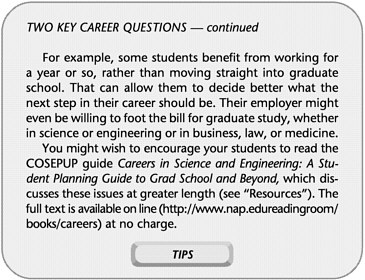
Undergraduates: Early Perspectives
Many undergraduates have little idea what kind of career they can anticipate. If you as mentor are happy and successful in what you do, it might be natural to encourage a student to follow in your footsteps. Remember, however, that each student is unique and needs to be encouraged to select the most-appropriate path for him or her. Avoid the
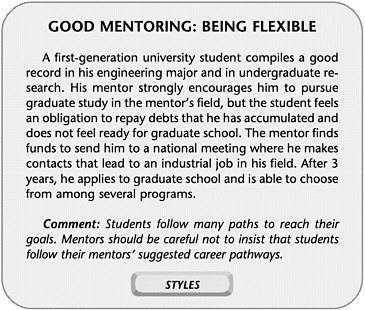
temptation to treat students as "clones" of yourself (see box "Good Mentoring: Being Flexible").
One challenge for many mentors is to stay current on employment trends in their field, especially if they have worked on campus for many years. You can monitor major trends with a small investment of time by visiting some of the on line sites mentioned in "Resources." And you can investigate the local career-planning center and your institution's alumni network. Encourage students to visit workplaces, to arrange to "shadow" people on the job, and to find off-campus internships and summer placements. There is no substitute for practical experience in learning what one is good at, what a field is like, and what scientists and engineers actually do.
When a student has trouble articulating goals, be pa-
tient. As long as students are interested and engaged in their work, they shouldn't be pressured. Goals must evolve at a natural pace. Remind students that they will almost certainly have multiple positions and perhaps even multiple careers, which is the strongest reason to aim for flexibility in qualification and experience.
Graduate Students: Helping Students Become Colleagues
Once a student begins a job search in earnest, there are many ways the mentor can help, from encouragement and advice to direct recommendations. When possible, arrange a telephone call or face-to-face meeting, which can be far more persuasive than a letter. Introduce students to members of your own network of contacts and urge them to extend that network themselves.
Recommend other search aids, including Internet sources (such as the NRC Career Planning Center), professional societies, and ads in journals and major newspapers. Keep handy your own list of telephone numbers and addresses, especially of former students, that might be helpful. (See "Resources" for more ideas.)
After spending years in graduate school, some students might devalue their own abilities or feel that they are too specialized for many employment positions. Remind them that they have acquired not only a series of credentials and a vocation, but a range of transferable skills-including analytical reasoning, program design and management, communication, evaluation, integration, and objectivity-that can be applied in many occupations.
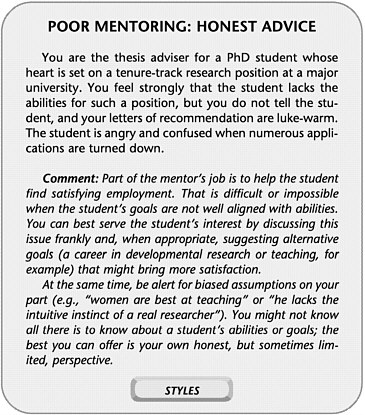
Postdoctoral Students: Finding a "Real" Job
Mentors can help postdoctoral students prepare for jobs by helping them to sharpen the skills listed above and to design a good CV, rehearse interviews, and learn about the current job market. In many cases, the most useful function of mentors is to introduce postdoctoral student to their own contacts, who might be able to offer or point to desirable positions.
Help students be aware of local resources for job-seek-
ers, including the institution's career center, bulletin boards, or professional meetings where jobs are advertised.
Keep in touch with candidates' progress by discussing the results of their interviews and job applications. Many faculty avoid this subject and end up offering insensitive or irrelevant advice.
Discuss career goals with the postdoctoral students and provide honest feedback, even when this is difficult. Provide examples of nonacademic, as well as academic, role models.
The Career as Continuum
At every level, the student should learn to look at academic and professional activities as parts of a single or branching continuum. As the student views course work, summer jobs, and practical experience as part of a single journey, the transition from student to professional activities can be smooth and satisfying. Each student activity is best regarded as a long-term investment in a life's work.











